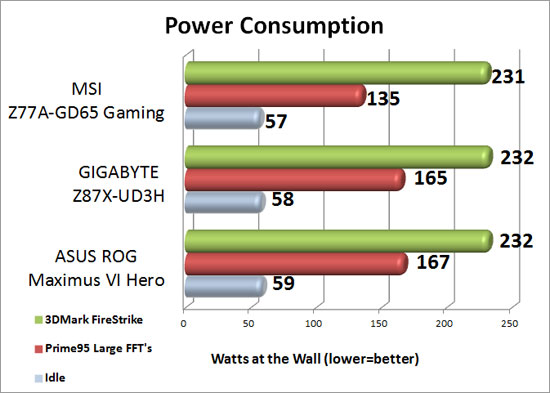GIGABYTE Z87X-UD3H Intel Z87 ‘Haswell’ Motherboard Review
Power Consumption

Since power consumption is a big deal these days, we ran some simple power consumption tests on our test beds. The systems ran with the power supplies, case fans, video cards and hard drives. To measure idle usage, we ran the system at idle for one hour on the desktop with no screen saver and took the measurement. For load measurements, Prime95’s in-place large FFT’s were run on all cores to make sure each and every processor was at 100% load for maximum power consumption and heat. Curious about real world scenarios, we decided to drop Furmark and ran 3DMark 11 on the performance preset and took the maximum power consumption during the first GPU test.

Benchmark Results: Power consumption was pretty constant across the board with the exception of the Prime95 load. At idle the boards ranged between 57 and 59 Watts at the wall with the GIGABYTE Z87X-UD3H falling in the middle at 58 Watts. Running 3DMark Firestrike our two Intel Z87 boards were both pulling a peak of 232 Watts while our Intel Z77 system was 1 Watt lower at 231. Prime 95 gave me the opposite results of what I expected, the MSI Z77A-GD65 Gaming motherboard with the Intel Core i7 3770K ‘Ivy Bridge’ processor pulled only 135 Watts at the wall, The GIGABYTE Z87X-UD3H and ASUS Maximus VI Hero were pulling 30 Watts more at the wall! It was expected that the latest and greatest would be more power efficient, but our results show different. It could have something to do with early BIOS revisions compared to a much more mature BIOS build for the Intel Z77 Platform, or it could simply be the way that Prime95 loads up the different processors.

Comments are closed.